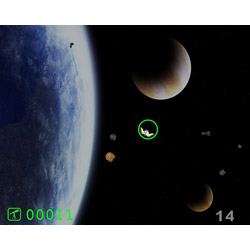
Visuomotor Skills: Visuomoter Coordination (VISMO) Module
Model 65317
The VISMO training program trains visuomotor coordination - the ability to coordinate hand and arm movements in response to visual stimuli.
Setting and Task
In the VISMO training program the client is instructed to observe the sky through a telescope. His task is to keep a particular object – a satellite, planet or spaceship – within the telescope’s finder (a green circle on the screen). Since the object is moving across the sky as it is being watched, the client must actively track it with the finder. The aim is not to lose the object from the finder. The longer the finder remains on the object, the more points the client accumulates.
Theory
Visuomotor coordination skills play an important part in many everyday situations such as driving a car, using household equipment or picking up objects.
Coordinating motor movements with visual stimuli requires a number of different abilities. First, it is necessary to identify what movements are necessary to achieve a particular goal. This involves creating internal models of the movement. After this the relevant movement must be planned and prepared, and finally the movement is executed. While the movement is being performed, the individual must use visual feedback to monitor whether the desired goal is being achieved. If necessary the movement must be changed, or a new movement may need to be initiated. At the same time, all external influences on the movement – such as gravity – must be taken into account.
VISMO trains clients' visuomotor coordination by means of tracking tasks. These involve using a joystick to keep a circle positioned over a target object on the screen. The target object moves across the screen along a path that varies in its degree of complexity. A number of studies have shown that regular training with tasks of this type improves visuomotor performance in patients with motor disabilities. There is also evidence that these tasks can improve visuomotor ability even in people without motor disabilities.
Difficulty Structure
The VISMO training program has 22 difficulty levels. Training adapts to the client’s performance level in four ways. As the difficulty level increases the path along which the target object travels becomes invisible and increasingly difficult to follow, the speed of the target object increases and the number of distracting objects in the scene also increases.
